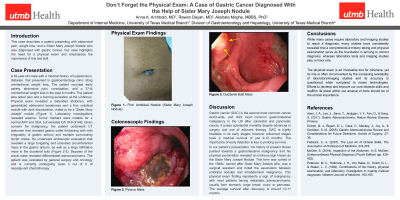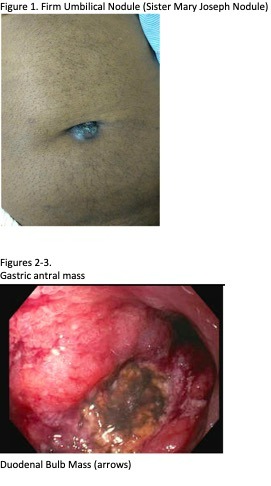Back


Poster Session B - Monday Morning
Category: Stomach
B0705 - Don't Forget the Physical Exam: A Case of Gastric Cancer Diagnosed With the Help of a Sister Mary Joseph Nodule
Monday, October 24, 2022
10:00 AM – 12:00 PM ET
Location: Crown Ballroom

Has Audio

Anna Archbold, MD
UTMB
Galveston, TX
Presenting Author(s)
Anna Archbold, MD1, Rawan Dayah, MD2, Akshata Moghe, MBBS, PhD2
1UTMB, Galveston, TX; 2University of Texas Medical Branch at Galveston, Galveston, TX
Introduction: This case describes a patient presenting with abdominal pain, weight loss, and a Sister Mary Joseph Nodule who was diagnosed with gastric cancer. Our case highlights the need for a physical exam and emphasizes the importance of this lost skill.
Case Description/Methods: Our patient is a 62-year-old male with a medical history of hypertension, diabetes, that presented to gastroenterology clinic citing unintentional weight loss. The patient reported early satiety, abdominal pain, constipation, and a 37-lb unintentional weight loss in the past 6 months. The patient also noted pain and a burning sensation at the umbilicus. Physical exam revealed a distended abdomen, with generalized abdominal tenderness and a firm umbilical nodule with dark discoloration, noted to be a ’Sister Mary Joseph’ nodule (Figure 1). Laboratory investigations revealed anemia. Tumor markers were notable for a normal AFP and CEA, but elevated CA 19-9 of 346. Given concern for malignancy, the patient underwent CT abdomen that revealed gastric outlet thickening with mild irregularity of gastric antrum and multiple surrounding lymph nodes. He underwent endoscopic evaluation that revealed a large fungating and ulcerated circumferential mass in the gastric antrum, as well as a large infiltrative mass in the duodenal bulb (Figure 2-3). Biopsies of the antral mass revealed differentiated adenocarcinoma. The patient was evaluated by general surgery and oncology and is currently undergoing cycle 3 out of 5 of neoadjuvant chemotherapy.
Discussion: Gastric cancer (GAC) is the second most common cancer world-wide, and third most common gastrointestinal malignancy in the US after colorectal and pancreatic cancer. It poses substantial mortality despite advances in surgery and use of adjuvant therapy. GAC is highly treatable in its early stages; however advanced stages have a medical survival of just 9-10 months. The importance of early detection is key to prolong survival.
Recent reports have mourned the lost art of the physical exam with the increased availability of laboratory testing and imaging studies. However, comprehensive history taking, and physical examination serve as the foundation in arriving at the correct diagnosis. In our patient’s case, both his suggestive history and the pathognomonic nodule on his exam expedited his diagnosis and management. The nodule has been named after Sister Mary Joseph who was a surgical assistant and noted the association between umbilical nodules and intrabdominal malignancy in the 1940s.

Disclosures:
Anna Archbold, MD1, Rawan Dayah, MD2, Akshata Moghe, MBBS, PhD2. B0705 - Don't Forget the Physical Exam: A Case of Gastric Cancer Diagnosed With the Help of a Sister Mary Joseph Nodule, ACG 2022 Annual Scientific Meeting Abstracts. Charlotte, NC: American College of Gastroenterology.
1UTMB, Galveston, TX; 2University of Texas Medical Branch at Galveston, Galveston, TX
Introduction: This case describes a patient presenting with abdominal pain, weight loss, and a Sister Mary Joseph Nodule who was diagnosed with gastric cancer. Our case highlights the need for a physical exam and emphasizes the importance of this lost skill.
Case Description/Methods: Our patient is a 62-year-old male with a medical history of hypertension, diabetes, that presented to gastroenterology clinic citing unintentional weight loss. The patient reported early satiety, abdominal pain, constipation, and a 37-lb unintentional weight loss in the past 6 months. The patient also noted pain and a burning sensation at the umbilicus. Physical exam revealed a distended abdomen, with generalized abdominal tenderness and a firm umbilical nodule with dark discoloration, noted to be a ’Sister Mary Joseph’ nodule (Figure 1). Laboratory investigations revealed anemia. Tumor markers were notable for a normal AFP and CEA, but elevated CA 19-9 of 346. Given concern for malignancy, the patient underwent CT abdomen that revealed gastric outlet thickening with mild irregularity of gastric antrum and multiple surrounding lymph nodes. He underwent endoscopic evaluation that revealed a large fungating and ulcerated circumferential mass in the gastric antrum, as well as a large infiltrative mass in the duodenal bulb (Figure 2-3). Biopsies of the antral mass revealed differentiated adenocarcinoma. The patient was evaluated by general surgery and oncology and is currently undergoing cycle 3 out of 5 of neoadjuvant chemotherapy.
Discussion: Gastric cancer (GAC) is the second most common cancer world-wide, and third most common gastrointestinal malignancy in the US after colorectal and pancreatic cancer. It poses substantial mortality despite advances in surgery and use of adjuvant therapy. GAC is highly treatable in its early stages; however advanced stages have a medical survival of just 9-10 months. The importance of early detection is key to prolong survival.
Recent reports have mourned the lost art of the physical exam with the increased availability of laboratory testing and imaging studies. However, comprehensive history taking, and physical examination serve as the foundation in arriving at the correct diagnosis. In our patient’s case, both his suggestive history and the pathognomonic nodule on his exam expedited his diagnosis and management. The nodule has been named after Sister Mary Joseph who was a surgical assistant and noted the association between umbilical nodules and intrabdominal malignancy in the 1940s.

Figure: Images of Sister Mary Joseph Nodule and endoscopy.
Disclosures:
Anna Archbold indicated no relevant financial relationships.
Rawan Dayah indicated no relevant financial relationships.
Akshata Moghe indicated no relevant financial relationships.
Anna Archbold, MD1, Rawan Dayah, MD2, Akshata Moghe, MBBS, PhD2. B0705 - Don't Forget the Physical Exam: A Case of Gastric Cancer Diagnosed With the Help of a Sister Mary Joseph Nodule, ACG 2022 Annual Scientific Meeting Abstracts. Charlotte, NC: American College of Gastroenterology.
